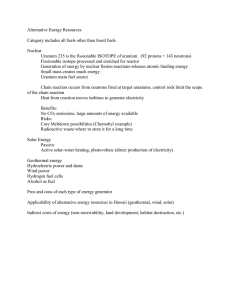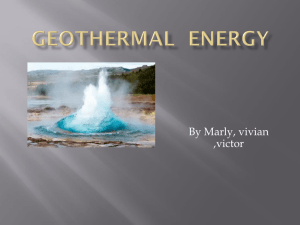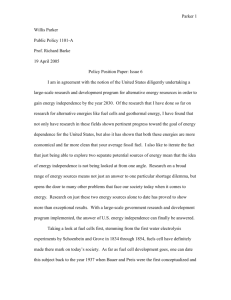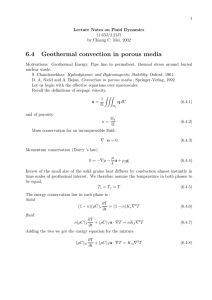Willis Parker Public Policy 1101-A Prof. Richard Barke 15 February 2005
advertisement
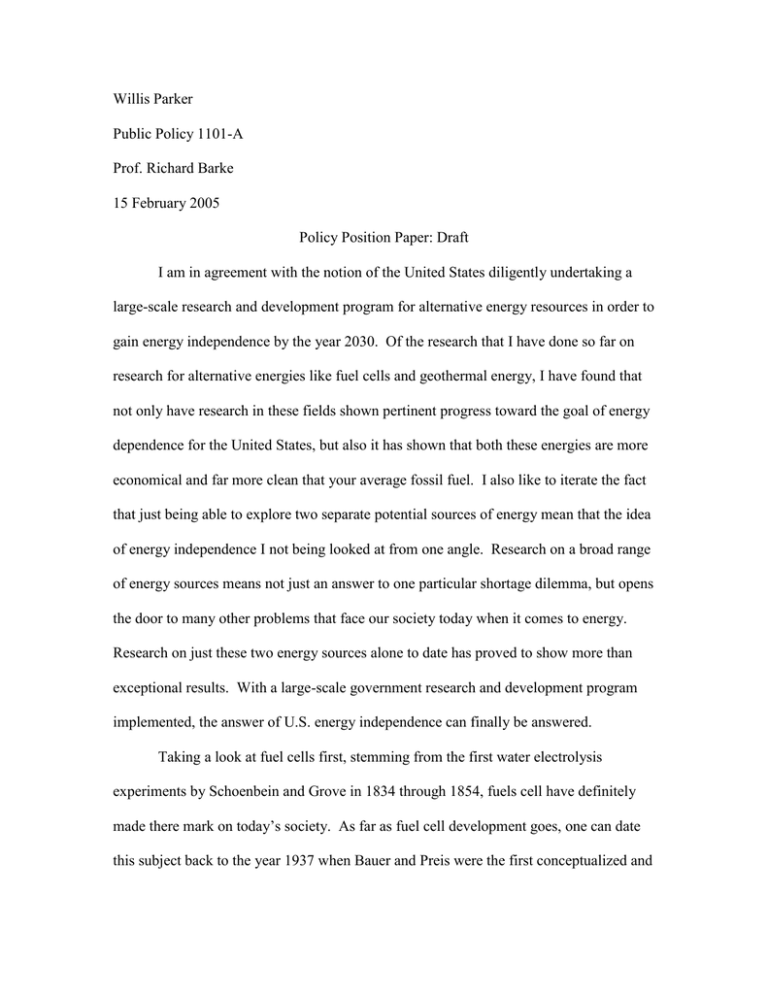
Willis Parker Public Policy 1101-A Prof. Richard Barke 15 February 2005 Policy Position Paper: Draft I am in agreement with the notion of the United States diligently undertaking a large-scale research and development program for alternative energy resources in order to gain energy independence by the year 2030. Of the research that I have done so far on research for alternative energies like fuel cells and geothermal energy, I have found that not only have research in these fields shown pertinent progress toward the goal of energy dependence for the United States, but also it has shown that both these energies are more economical and far more clean that your average fossil fuel. I also like to iterate the fact that just being able to explore two separate potential sources of energy mean that the idea of energy independence I not being looked at from one angle. Research on a broad range of energy sources means not just an answer to one particular shortage dilemma, but opens the door to many other problems that face our society today when it comes to energy. Research on just these two energy sources alone to date has proved to show more than exceptional results. With a large-scale government research and development program implemented, the answer of U.S. energy independence can finally be answered. Taking a look at fuel cells first, stemming from the first water electrolysis experiments by Schoenbein and Grove in 1834 through 1854, fuels cell have definitely made there mark on today’s society. As far as fuel cell development goes, one can date this subject back to the year 1937 when Bauer and Preis were the first conceptualized and create solid oxide fuel cells. With years to come, research and development due to space programs (in the 1960s and 1970s), and design tweaks in the 1980s, fuel cells finally became commercially available in the 1990s. The advantages of fuel cells that are most intriguing are its high energy conversion (40-60%) and low emission of greenhouse gases. With attributes like these, fuel cells have been considered to be the alternative energy source to reduce oil dependency. Not only does fuel cells produce a sufficient amount of energy, but it also is far cleaner and requires low maintenance. As for the present day, it just so happens that the company leading in fuel cell development and research, Fuel Cell Inc., is based in Danbury, Connecticut. With all the research done recently within this field, the public now enjoy certain innovations like the hybrid automobile which also plays a role in energy independence as well. With as much time and effort that was put into this field alone, the United States, not to mention the entire world, is now possibly on the brink of not only energy independence for separate countries, but on the brinks of coming up with an answer to the age old question of what will mankind look toward for future sources of energy if our natural resources can possibly be depleted one day. If government research and development was implemented on a large scale then the possibility of an adequate alternative energy source could finally be realized. Although geothermal energy is the newer of the two energy sources that I am discussing, it also shows the potential of leading the United States towards energy independence. Starting its research and development in 1971 by DOE (the Department of Energy), geothermal energy is now making the move to provide energy to the western United States through electricity and heating. As one can already guess, geothermal power is both renewable and more cost efficient than crude oil or natural gas. Right now, geothermal energy is only in its incipient stage, but the DOE has set goals of doubling the amount of geothermal energy facilities by next year, dropping the cost of production by 5 to 7 cents per kWh by 2007, and to supply at least 7million homes and businesses with either geothermal electricity or heat by 2010 as reported in its annual fiscal report in 2003. Although the development of this technology is quite astounding in itself, its almost useless if the DOE cannot find consumers to utilize this energy source. In fact, the DOE funded $455,000 just for the programs that trained and educated the public as well as developers on the potential and convenience of geothermal energy. In fact, as for funding the entire development, research, and education of geothermal energy has cost the DOE millions of dollars in 2003 alone. If ever that much money is invested into an idea then it’s obvious that some group (namely the DOE) has high expectations for this somewhat modern energy supply. In all however, one of the main goal, as I may have mention earlier for geothermal energy, is to lower the cost of production in order to lower the cost for consumption. From the looks of things the whole plan of the Department of Energy was to make this energy widely available so that the U.S. would turn to geothermal energy as an alternative.
